Asus has never been a company to shy away from offering over-the-top, custom products that command a price premium. Here's proof. Perhaps it’s because the company is large enough, and thus, has the resources to cater to virtually all market segments, big or small. Or perhaps the top brass at Asus just likes inducing slack-jawed stares from PC enthusiasts. Whatever the reason, we hope they keep it up because testing this kind of stuff and showing it to you all is freakin’ fun.
A case-in-point is the Asus MARS II graphics card, which packs a full GeForce GTX 580, dual-GPU SLI configuration onto a single PCB. A quick glance at this monolith should reveal to even the most casual PC users that the MARS II is no ordinary graphics card. Heck, there isn’t a single thing about the Asus MARS II, from its specs, to its sheer size, and its huge price tag, that can be considered mainstream. The MARS II is as over-the-top and as custom as they get and it’s also going to be a limited edition, with only 999 cards slated for production.
Luckily, one of those 999 cards (number 545 to be exact) found its way into the HH labs and we’re able to give you the full scoop on this beast. Specifications and a few pics are below; the full Monty is laid out on the pages ahead.
A case-in-point is the Asus MARS II graphics card, which packs a full GeForce GTX 580, dual-GPU SLI configuration onto a single PCB. A quick glance at this monolith should reveal to even the most casual PC users that the MARS II is no ordinary graphics card. Heck, there isn’t a single thing about the Asus MARS II, from its specs, to its sheer size, and its huge price tag, that can be considered mainstream. The MARS II is as over-the-top and as custom as they get and it’s also going to be a limited edition, with only 999 cards slated for production.
Luckily, one of those 999 cards (number 545 to be exact) found its way into the HH labs and we’re able to give you the full scoop on this beast. Specifications and a few pics are below; the full Monty is laid out on the pages ahead.
|
| Model | MARS II/2DIS/3GD5 |
| Graphics Engine | NVIDIA GeForce GTX 580 x2 |
| Bus Standard | PCI Express 2.0 |
| Video Memory | 3GB GDDR5 |
| Engine Clock | 782MHz |
| Memory Clock | 4008MHz (1002MHz GDDR5) |
| Memory Interface | 384-bit x2 |
| D-sub Max. Resolution | 2048 x 1536 |
| DVI Max. Resolution | 2560 x 1600 |
| D-sub Output | Yes x 1 (via DVI-to-D-sub adaptor) |
| DVI Output | Yes x 2 (Native dual link DVI x2) |
| HDCP compliant | Yes |
| HDMI Output | Yes x 1 (Native HDMI 1.4) |
| Display Port | Yes x 1 (Regular DisplayPort) |
| Adaptor/Cable Bundled | 1x Limited Edition aluminum ID plate |
| 2x 8-pin to 6-pin Power Cable | |
| 1x DVI-to-D-sub adaptor | |
| 1x Exclusive 12cm SLI bridge | |
| Software Bundled | ASUS utilities and drivers; GPU Tweak |
| Dimension | 13 inch x 6.2 inch x2.5 inch(3slot) |
| Note | To have the best cooling performance ASUS ROG MARS II extends the Fan sink to 3 slot, please check your motherboard slot space and Chassis Dimension before Purchasing |
| ASUS ROG Rampage III Extreme or Rampage III Extreme Black Edition Mainboard is recommended for best Synergy |
Before we dive in, dissect the Asus MARS II and evaluate its performance, here’s a look at its packaging and accessory bundle. For the most part, it’s pretty standard fair. Included with the card are a couple of 8-pin PCI Express power adapters, a DVI-to-VGA adapter (for the insane user who uses a $1500 graphics card with an analog display), a driver and utility CD (with Asus' excellent GPU Tweak tool), a RoG case badge, a speed-setup guide, and an extended length SLI bridge.
In addition to the aforementioned items though, Asus also throws in a couple of noteworthy goodies. First is an aluminum plate that’s individually laser-engraved and sequentially numbered to certify the card’s limited edition status. Second, there are a couple of spacers that Asus calls “PCIe Sustainers”. These spacers adhere to the bottom of the card and rest upon adjacent expansion slots to ensure the MARS II sits perfectly straight and upright in its slot. Why would you need spacers to help keep the card sitting upright? Because the thing weighs over 5lbs.
In addition to the aforementioned items though, Asus also throws in a couple of noteworthy goodies. First is an aluminum plate that’s individually laser-engraved and sequentially numbered to certify the card’s limited edition status. Second, there are a couple of spacers that Asus calls “PCIe Sustainers”. These spacers adhere to the bottom of the card and rest upon adjacent expansion slots to ensure the MARS II sits perfectly straight and upright in its slot. Why would you need spacers to help keep the card sitting upright? Because the thing weighs over 5lbs.
Let’s get down to business. As we’ve mentioned, the Asus MARS II packs a full GeForce GTX 580 SLI, dual-GPU configuration onto a single board. Doing so required some significant engineering on Asus’ part to deal with the power and heat requirements of such a configuration. Asus pulled it off though, by equipping the MARS II with a new “SAP”, or Super Alloy Power VRM capable of 600W of power delivery, binning the GPUs, outfitting the GPUs with DirectCU heatsinks, and capping everything off with a pair of 120mm cooling fans.
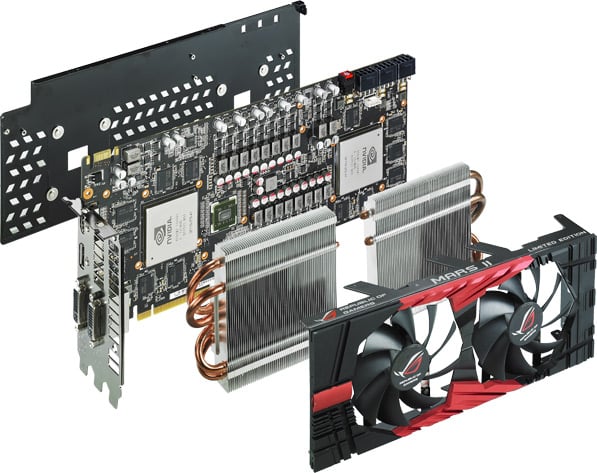
Asus MARS II Exloded View
The exploded view of the Asus MARS II above shows just how complex a product the card really is. The two large heatsinks rest directly atop each GPU. Memory chips flank three sides of each GPU with the SAP VRM smack dab in the middle. A heavy-duty metal backplane adds some much needed rigidity to the card and protects the entire backside. And a large shroud / fan housing covers the front. We should point out that the two fans on the MARS II are capable of pushing 220CFM. For comparison, the fan on a GTX 590 can move 32CFM.

Asus MARS II PCB
Providing smooth, clean power is paramount for any graphics card, but especially for something as complex as the MARS II. To that end, Asus outfitted the card with a 21-phase VRM comprised of “super alloy” chokes, caps, and M.O.S.F.E.T.s, capped off my Asus’ super-hybrid engine. According to Asus, the SAP VRM “utilizes metals that are highly-magnetic, heat-resistant and anti-corrosive to reduce power loss, enhance durability and achieve cooler operation.” Also part of the SAP VRM is a pair of NEC / Tokin Prodalizers mounted directly behind each GPU. These prodalizers offer high capacitance and low ESR for clean power delivery and they’re placed as close to the GPUs are possible to increase efficiency and effectiveness.
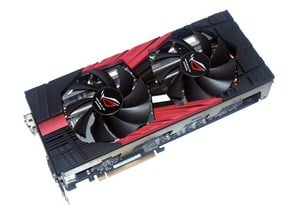
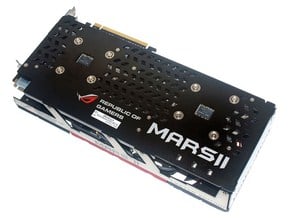

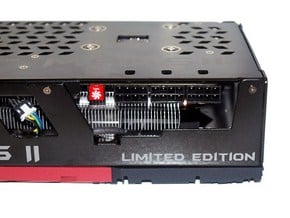
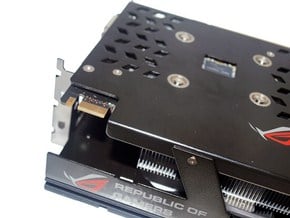
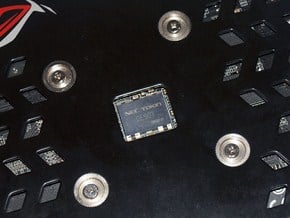
Unlike the dual-GPU GeForce GTX 590, which is clocked much lower than the GTX 580, by going all out on its power delivery circuitry and cooling apparatus, Asus is able to provide a no-compromise (in terms of performance and features) GeForce GTX 580 SLI setup on a single-PCB, that runs at slightly higher stock frequencies than a pair of reference cards. The GPUs on the Asus MARS II are clocked at 782MHz (1564MHz shaders) and its 3GB of Samsung GDDR5 memory at 1002MHz (4008MHz effective). Reference GeForce GTX 580 cards have the same speed memory with GPUs that run at 772MHz.
As you look through the pics, you’ll notice the Asus MARS II requires a trio of 8-pin PCIe supplemental power connectors, for a total power (including the 75W available through a PCIe x16 slot) of 525W (150+150+150+75). To dissipate all the heat generated by a card that can use that much power, the two 120mm fans blow air directly onto the large heatsinks w/ copper heatpipes installed on each GPU. At idle, its fans generate about 21db of noise. When spun up to their max speed, the fans output upwards of 48.5db. Also note that there is a push-button switch right on the MARS II that will immediately run the fans at their maximum speed. Asus put that switch there for extreme overclockers that don’t want to mess around with software to tweak fan speeds.
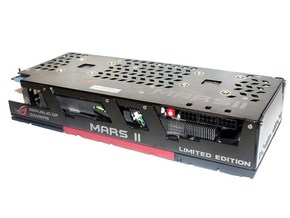

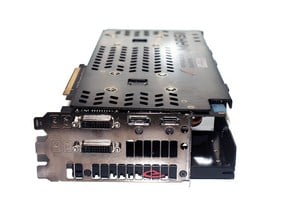
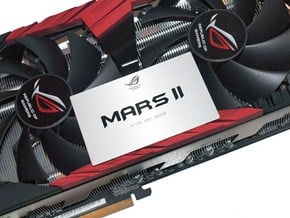
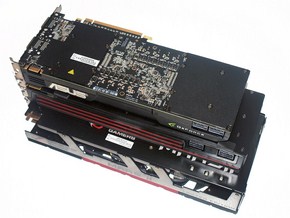
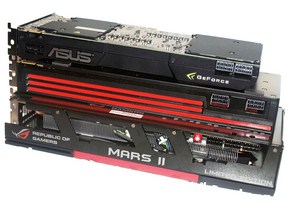
In case you haven’t noticed up to this point, the Asus MARS II is huge. Really huge. The card measures in at 13” x 6.2” x 2.5”and almost 5.4lbs. It’s three-slots wide and dwarfs the Radeon HD 6990 and GeForce GTX 590. The thing is just plain imposing to look at.
Although it’s very big, Asus did make an effort to gussy up the card quite a bit. The backplate is perforated in a slick chevron pattern, the heatsinks in the front fan shroud mimic those on Asus’ Rampage series motherboards, and there is RoG—Republic of Gamers—messaging throughout. If you look close, you may even see the elongated “G” hiding behind the vents in the case bracket.
The Asus MARS II is a triple-slot solution, so you’ll need a board with enough room to accommodate this behemoth if you plan to get in on the action. On the card’s triple-slot case bracket its dual-DVI outputs, DisplayPort and HDMI outputs are visible. The MARS II does support NVIDIA 3D Vision Surround on its own. Not to mention, two cards can be paired together in a quad-SLI configuration as well. Good God.
How We Configured Our Test Systems: We tested the graphics cards in this article on a Gigabyte GA-EX58-UD5 motherboard powered by a Core i7 980X six-core processor and 6GB of OCZ DDR3-1333 RAM. The first thing we did when configuring the test system was enter the system BIOS and set all values to their "optimized" or "high performance" default settings. Then we manually configured the memory timings (DDR3-1333, CAS 7) and disabled any integrated peripherals that wouldn't be put to use. The hard drive was then formatted and Windows 7 Ultimate x64 was installed. When the installation was complete we fully updated the OS and installed the latest DirectX redist, along with the necessary drivers, games, and benchmark applications.


Do you see these two graphs? The ones with the longer bars in attached to the Asus MARS II entry? Get used to 'em, because the Unigine Heaven Benchmark isn't the only one that the Asus MARS II dominated. As you can see, Asus' powerhouse outran both the GeForce GTX 590 and Radeon HD 6990 by a wide margin here.

Asus MARS II Exloded View
The exploded view of the Asus MARS II above shows just how complex a product the card really is. The two large heatsinks rest directly atop each GPU. Memory chips flank three sides of each GPU with the SAP VRM smack dab in the middle. A heavy-duty metal backplane adds some much needed rigidity to the card and protects the entire backside. And a large shroud / fan housing covers the front. We should point out that the two fans on the MARS II are capable of pushing 220CFM. For comparison, the fan on a GTX 590 can move 32CFM.

Asus MARS II PCB
Providing smooth, clean power is paramount for any graphics card, but especially for something as complex as the MARS II. To that end, Asus outfitted the card with a 21-phase VRM comprised of “super alloy” chokes, caps, and M.O.S.F.E.T.s, capped off my Asus’ super-hybrid engine. According to Asus, the SAP VRM “utilizes metals that are highly-magnetic, heat-resistant and anti-corrosive to reduce power loss, enhance durability and achieve cooler operation.” Also part of the SAP VRM is a pair of NEC / Tokin Prodalizers mounted directly behind each GPU. These prodalizers offer high capacitance and low ESR for clean power delivery and they’re placed as close to the GPUs are possible to increase efficiency and effectiveness.
Unlike the dual-GPU GeForce GTX 590, which is clocked much lower than the GTX 580, by going all out on its power delivery circuitry and cooling apparatus, Asus is able to provide a no-compromise (in terms of performance and features) GeForce GTX 580 SLI setup on a single-PCB, that runs at slightly higher stock frequencies than a pair of reference cards. The GPUs on the Asus MARS II are clocked at 782MHz (1564MHz shaders) and its 3GB of Samsung GDDR5 memory at 1002MHz (4008MHz effective). Reference GeForce GTX 580 cards have the same speed memory with GPUs that run at 772MHz.
As you look through the pics, you’ll notice the Asus MARS II requires a trio of 8-pin PCIe supplemental power connectors, for a total power (including the 75W available through a PCIe x16 slot) of 525W (150+150+150+75). To dissipate all the heat generated by a card that can use that much power, the two 120mm fans blow air directly onto the large heatsinks w/ copper heatpipes installed on each GPU. At idle, its fans generate about 21db of noise. When spun up to their max speed, the fans output upwards of 48.5db. Also note that there is a push-button switch right on the MARS II that will immediately run the fans at their maximum speed. Asus put that switch there for extreme overclockers that don’t want to mess around with software to tweak fan speeds.
In case you haven’t noticed up to this point, the Asus MARS II is huge. Really huge. The card measures in at 13” x 6.2” x 2.5”and almost 5.4lbs. It’s three-slots wide and dwarfs the Radeon HD 6990 and GeForce GTX 590. The thing is just plain imposing to look at.
Although it’s very big, Asus did make an effort to gussy up the card quite a bit. The backplate is perforated in a slick chevron pattern, the heatsinks in the front fan shroud mimic those on Asus’ Rampage series motherboards, and there is RoG—Republic of Gamers—messaging throughout. If you look close, you may even see the elongated “G” hiding behind the vents in the case bracket.
The Asus MARS II is a triple-slot solution, so you’ll need a board with enough room to accommodate this behemoth if you plan to get in on the action. On the card’s triple-slot case bracket its dual-DVI outputs, DisplayPort and HDMI outputs are visible. The MARS II does support NVIDIA 3D Vision Surround on its own. Not to mention, two cards can be paired together in a quad-SLI configuration as well. Good God.
How We Configured Our Test Systems: We tested the graphics cards in this article on a Gigabyte GA-EX58-UD5 motherboard powered by a Core i7 980X six-core processor and 6GB of OCZ DDR3-1333 RAM. The first thing we did when configuring the test system was enter the system BIOS and set all values to their "optimized" or "high performance" default settings. Then we manually configured the memory timings (DDR3-1333, CAS 7) and disabled any integrated peripherals that wouldn't be put to use. The hard drive was then formatted and Windows 7 Ultimate x64 was installed. When the installation was complete we fully updated the OS and installed the latest DirectX redist, along with the necessary drivers, games, and benchmark applications.
| |
|
| Hardware Used: Intel Core i7 980X (3.3GHz, Six-Core) Gigabyte EX58-UD5 (Intel X58 Express) Radeon HD 6990 Radeon HD 6970 GeForce GTX 580 GeForce GTX 590 Asus MARS II 6GB OCZ DDR3-1333 Western Digital Raptor 150GB Integrated Audio Integrated Network | Relevant Software: Windows 7 Ultimate x64 DirectX April 2011 Redist ATI Catalyst v11.8 NVIDIA GeForce Drivers 280.26 Benchmarks Used: Unigine Heaven v2.5 Futuremark 3DMark11 FarCry 2 Just Cause 2 Alien vs. Predator Metro 2033 Lost Planet 2 F1 2010 |
| |
|
 Unigine Heaven | Unigine's Heaven Benchmark v2.5 is built around the Unigine game engine. Unigine is a cross-platform, real-time 3D engine, with support for DirectX 9, DirectX 10, DirectX 11 and OpenGL. The Heaven benchmark--when run in DX11 mode--also makes comprehensive use of tessellation technology and advanced SSAO (screen-space ambient occlusion) It also features volumetric cumulonimbus clouds generated by a physically accurate algorithm and a dynamic sky with light scattering. |


Do you see these two graphs? The ones with the longer bars in attached to the Asus MARS II entry? Get used to 'em, because the Unigine Heaven Benchmark isn't the only one that the Asus MARS II dominated. As you can see, Asus' powerhouse outran both the GeForce GTX 590 and Radeon HD 6990 by a wide margin here.
|
 Futuremark 3DMark11 | The latest version of Futuremark's synthetic 3D gaming benchmark, 3DMark11, is specifically bound to Windows Vista and WIndows 7-based systems due to its DirectX 11 requirement, which isn't available on previous versions of Windows. 3DMark11 isn't simply a port of 3DMark Vantage to DirectX 11, though. With this latest version of the benchmark, Futuremark has incorporated four new graphics tests, a physics tests, and a new combined test. We tested the graphics cards here with 3DMark11's Extreme preset option, which uses a resolution of 1920x1080 with 4x anti-aliasing and 16x anisotropic filtering. |

Nothing could touch the Asus MARS II in the 3DMark11 benchmark. While running in AUSUM mode, the Radeon HD 6990 came within a few hundred points, but ultimately the MARS II was still more than 10% faster than the OC'd Radeon and about 18 - 22% faster than the stock 6990 and GTX 590.
Before bringing this article to a close, we'd like to cover a few final data points--namely power consumption, noise, and overclocking. Throughout all of our benchmarking and testing, we monitored how much power our test system was consuming using a power meter. Our goal was to give you an idea as to how much power each configuration used while idling and while under a heavy workload. Please keep in mind that we were testing total system power consumption at the outlet here, not just the power being drawn by the graphics cards alone.

Looking back at the numbers, it should come as no surprise that the Asus MARS II consumed the most power off all of the cards we tested, while idling and while under load. At idle our Asus MARS II-equipped test system consumed 43 more watts that its closest cousin, the GeForce GTX 590. And while under load the test system pulled a whopping 673 watts from the outlet. If you're worried about your carbon footprint, the MARS II is most definitely not for you. This card is extremely power hungry.
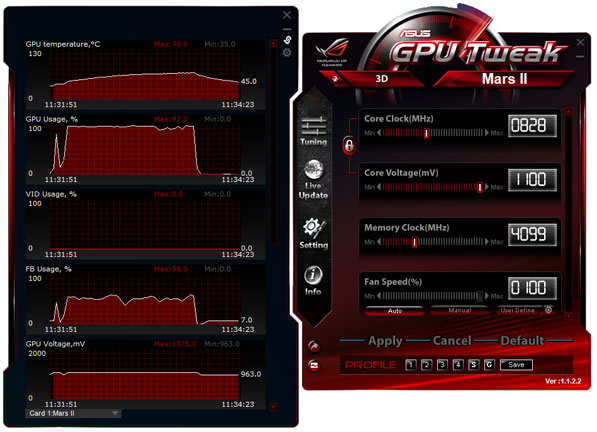
The Asus GPU Tweak Utility
The Asus MARS II includes a copy of the company's excellent GPU Tweak Utility, so we fired it up to do a bit of monitoring and overclocking as well. Asus has informed us that most cards will do 800MHz GPU clocks easily, the majority will do 820MHz, and a smaller number are hitting around 870MHz. We were easily able to hit 828MHz on the GPUs with a 90+MHz increase to the memory clock as well, but think there was more left in the tank. Unfortunately, we only had a limited time to test the card before cranking out this article, so we couldn't tweak much further. We should note, that while overclocked, the MARS II managed to put up 59.9 FPS in the AvP benchmark at 2560x1600, which was an 7 FPS increase over stock.
Using GPU Tweak, we also monitors temperatures on the MARS II during out benchmarking session. At idle, the card's GPUs typically hovered in the 40'C range and under load they hit 85'C consistently. Thankfully, the MARS II's massive cooler and fans do a good job of dissipating heat becuse the card cooled down rather quickly and even while under load it never got terribly loud. It wasn't quiet by any means under load, but it was definitely quieter than a Radeon HD 6990, to give you a frame a reference.
| |
|

Looking back at the numbers, it should come as no surprise that the Asus MARS II consumed the most power off all of the cards we tested, while idling and while under load. At idle our Asus MARS II-equipped test system consumed 43 more watts that its closest cousin, the GeForce GTX 590. And while under load the test system pulled a whopping 673 watts from the outlet. If you're worried about your carbon footprint, the MARS II is most definitely not for you. This card is extremely power hungry.
|

The Asus GPU Tweak Utility
The Asus MARS II includes a copy of the company's excellent GPU Tweak Utility, so we fired it up to do a bit of monitoring and overclocking as well. Asus has informed us that most cards will do 800MHz GPU clocks easily, the majority will do 820MHz, and a smaller number are hitting around 870MHz. We were easily able to hit 828MHz on the GPUs with a 90+MHz increase to the memory clock as well, but think there was more left in the tank. Unfortunately, we only had a limited time to test the card before cranking out this article, so we couldn't tweak much further. We should note, that while overclocked, the MARS II managed to put up 59.9 FPS in the AvP benchmark at 2560x1600, which was an 7 FPS increase over stock.
Using GPU Tweak, we also monitors temperatures on the MARS II during out benchmarking session. At idle, the card's GPUs typically hovered in the 40'C range and under load they hit 85'C consistently. Thankfully, the MARS II's massive cooler and fans do a good job of dissipating heat becuse the card cooled down rather quickly and even while under load it never got terribly loud. It wasn't quiet by any means under load, but it was definitely quieter than a Radeon HD 6990, to give you a frame a reference.
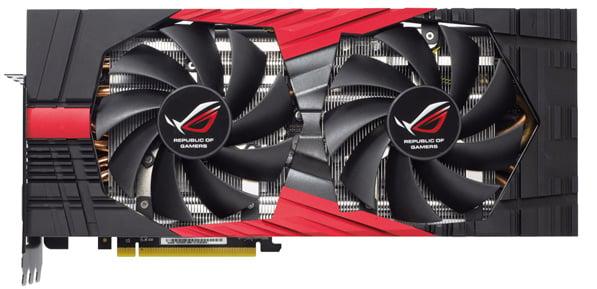


Tidak ada komentar:
Posting Komentar